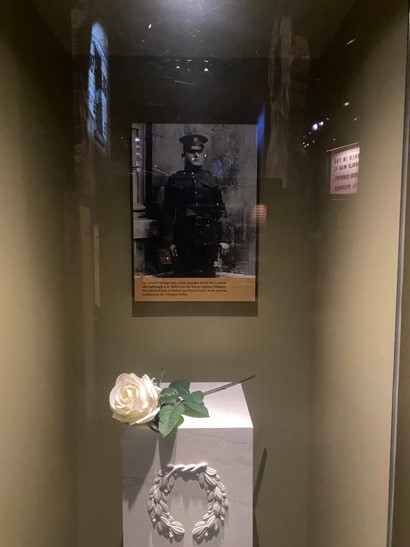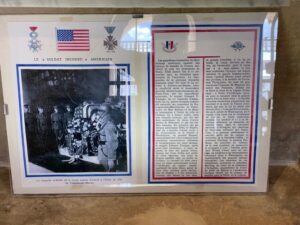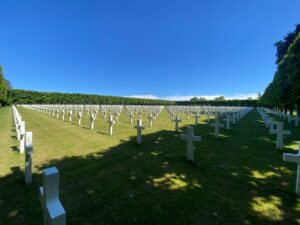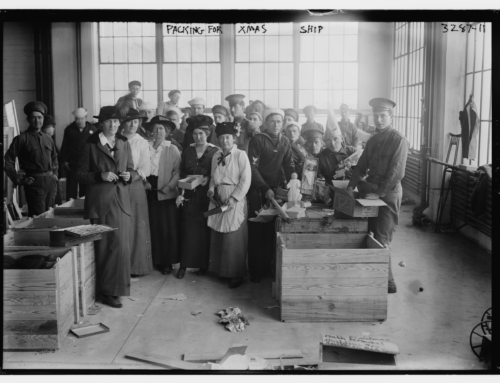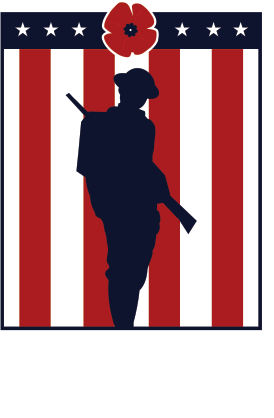One of Four: World War One Through the Eyes of an Unknown Soldier
Published: 7 June 2025
By Travis Davis
Special to the Doughboy Foundation website
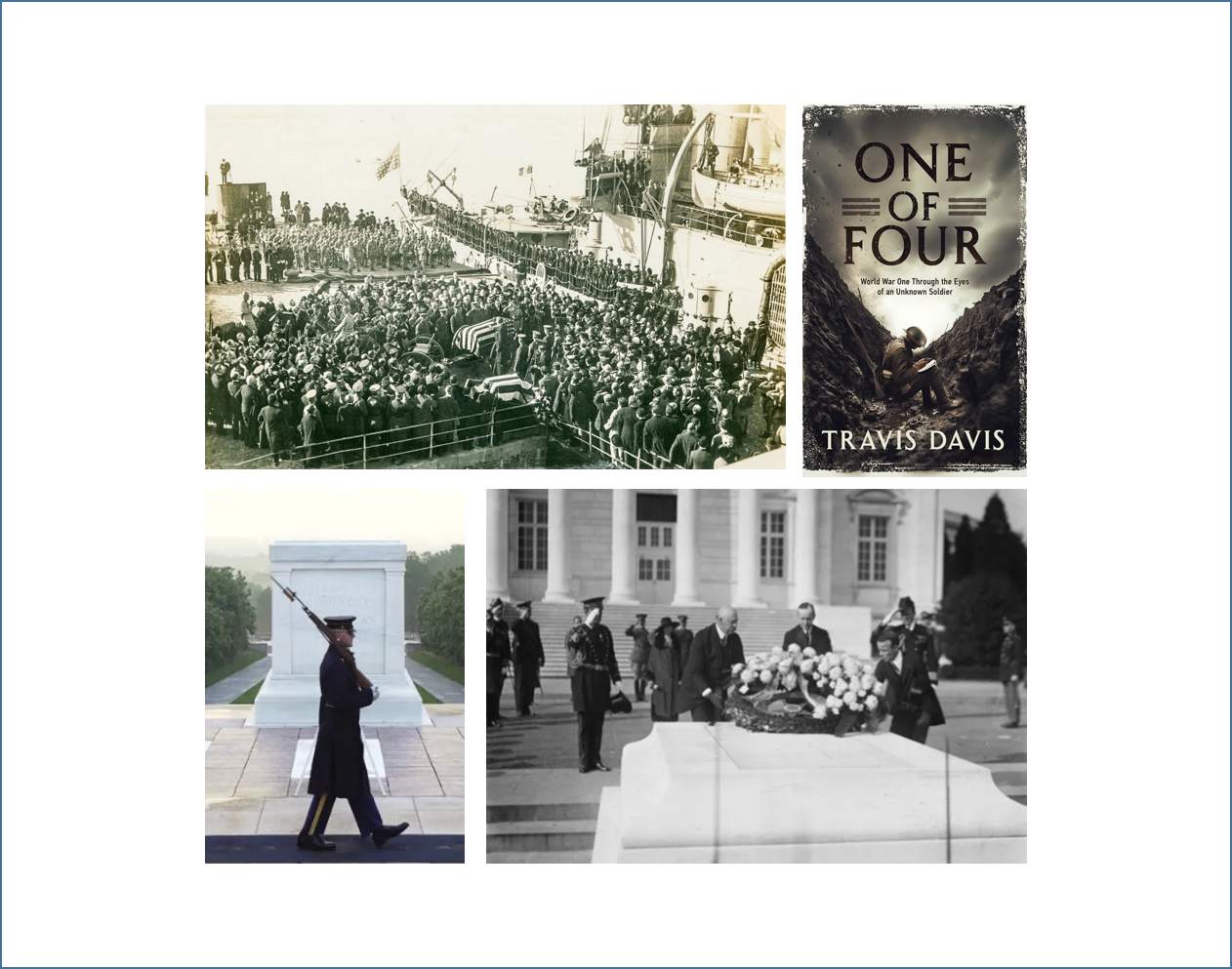
Tomb group framed
Top left: Casket of the Unknown Soldier being loaded aboard the USS Olympia in Le Havre, France in 1921. Bottom right: John W. Weeks and Calvin Coolidge lay a wreath at the Tomb of the Unknown Soldier at Arlington National Cemetery in 1923, Bottom left: Tomb Guard at the Tomb of the Unknown Soldier in 2021. Top Right: Travis Davis' new book, One of Four.
It was an extremely hot July day near Salina, Kansas, in 1977. A young Army Private First Class (PFC) assigned to Blues Platoon, Delta Troop 1/4th Cav, 1st Infantry Division, stood over the flag-draped casket of a World War I hero. He was a member of the burial detail to honor a fallen soldier. At the time, World War I was but a war he learned little about in school. Yet, in later years, he would become fixated on the war and the unknown soldier from World War I. 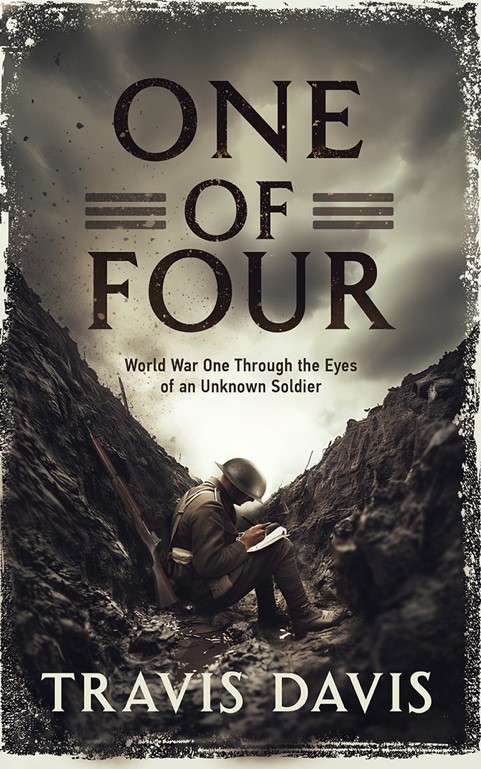 As the years went on, he decided to tell the unknown soldier’s story. One that the hero couldn’t tell, but would be told through his diary, and how that diary would have a profound effect on a father and son’s relationship over a hundred years later. That PFC was me.
As the years went on, he decided to tell the unknown soldier’s story. One that the hero couldn’t tell, but would be told through his diary, and how that diary would have a profound effect on a father and son’s relationship over a hundred years later. That PFC was me.
My novel, One of Four: World War One Through the Eyes of an Unknown Soldier. It’s not a war book, it’s a book about war and the ramifications war has on soldiers, their families, and non-combatants living in a country ravaged by war. Most of all, it’s a tribute to the unknown soldier and all the “Doughboys” that fought, the ones that came home, and the ones that gave it all.
On October 24th, 1921, the remains of four unknown soldiers were exhumed from grave sites at four American cemeteries in France: Aisne-Marne, Meuse-Argonne, Somme, and St. Mihiel. The four unknown soldiers were taken to the Hôtel de Ville (City Hall) of Chalons-sur-Marne. One of the four would be chosen to be entombed at the Tomb of the Unknown Soldier at Arlington National Cemetery in Virginia. Sergeant Edward F. Younger was honored with the task of selecting the soldier. With a spray of white roses given to him by a French father who had lost two sons in the war, he walked around the four caskets several times. He stopped at one of them and laid the white roses on the chosen unknown soldier. He stepped back from the casket, saluted the unknown soldier, and stepped aside.
The unknown soldier was placed on a special train for his journey to the port of Le Havre, where he had arrived many months earlier as a member of the 1st Expeditionary Forces. Along the route, citizens lined the streets to bid farewell to the unknown soldier. However, the local population recognized him. He was one of the heroes who gave his life fighting for their country. Many wept as the horse-drawn caisson passed.
At the port of Le Havre, his casket was loaded onto the USS Olympia for its journey across the Atlantic Ocean. On November 9, 1921, the ship docked at the Washington Naval Yard. There, his casket was placed on a horse-drawn caisson led by the 3rd Cavalry Regiment for its journey to the Capitol Rotunda, where it would lie in state for the public (over 90,000 citizens passed by the unknown soldier) to pay their respects until November 11, 1921.
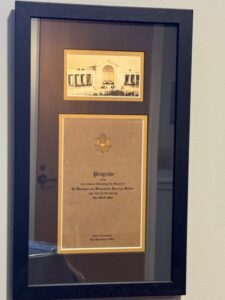
The Original Program from November 11th, 1921. The ceremony for the burial of the Unknown Soldier at Arlington National Cemetery – Guard House Tomb Sentinels, Tomb of the Unknown Soldier.
On November 11th, 1921, exactly three years after the war ended, the casket carrying the unknown soldier made its final journey home and its final resting place from the Capitol Rotunda through Washington D.C., across the Potomac River to Arlington National Cemetery. That day, the unknown soldier was placed under a simple marble slab, which today we call the Tomb of the Unknown Soldier.
My journey writing One of Four: World War One Through the Eyes of an Unknown Soldier was filled with learning, joy, heartache, and patriotism. What I didn’t know after writing it was that my wife and I would go to France and relive the diary. We visited every significant location in the book, and everywhere the unknown soldier went was based on historical facts. The port of Le Havre, the battlefields of northern France, the Meuse-Argonne National Cemetery, Châlons-sur-Marne (Châlons-en-Champagne), and the Tomb of the Unknown Soldier. While at the Meuse-Argonne National Cemetery, we located the graves of the other three unknown soldiers. They are located in Section G 1,2, and 3.
The soldiers who fought in the war were the first American troops to engage in combat in Europe. Most of them were first- and second-generation immigrants fighting for their new country. World War I was a war of firsts: machine guns, accurate artillery, poison gas, airplanes, and tanks, to name a few. However, with the introduction of these killing machines, death occurred on an unprecedented scale. An average of 6000 soldiers died each day, and alongside the dead were the horrific wounds the soldiers sustained in combat, some of which were visible, while many were not. The families, rehabilitation centers, and hospitals to which the soldiers returned were not prepared and ill-equipped for the physical wounds and mental issues they brought home. For many of them, the war never ended. Warfare would never be the same after World War I.
While writing One of Four, one of my main goals was to avoid degrading or detracting from the soldier entombed in the Tomb of the Unknown Soldier. I ensured that the soldier in the book had no specific characteristics or adopted the traits of anyone who fought in the war. To achieve this, I refrained from reading any letters or diaries from World War I soldiers. Instead, I utilized historical documents such as the History of the First Infantry Division, printed in 1922, and the First War History by Martin Gilbert, along with various online resources and visits to the Museum of the US Army and the Tomb of the Unknown Soldier. I wanted this to be his story, no one else’s. With this in mind, there are no physical descriptions, origins, names, units, or details about the soldiers he fought with. I often get asked who the soldier is in the book, to which I reply, I really don’t know; even to me, he is unknown. I aimed for the reader to visualize who he is based on the traits he possesses: courage, heroism, devotion, leadership, empathy, and spirituality. But most importantly, love and trust for his fellow soldiers—compassion for the French citizens caught up in the war. By the end of reading One of Four, I want the reader to think to themselves, yes, he could be the soldier in the tomb.
Through his diary, discovered by an estranged father and son in a bookstore in present-day Paris, readers will follow him from his arrival in France in June 1917, through his training for combat, life in the trenches, and the hell of No-Man’s Land until his death on the battlefield in the fall of 1918. In those eighteen months, he transforms from a private to a corporal, leading a squad in combat and telling his story through the entries in his diary, which allow the reader to visualize how war affected him and the soldiers around him. As the father and son relive World War I, the experience brings them closer than ever, as the son can finally see what war did to his father. A father and son’s bond becomes unbreakable.
In 1932, the completed Tomb of the Unknown Soldier was unveiled. A marble sarcophagus was placed above the grave of the unknown soldier from World War I. The sarcophagus was engraved with elaborate carvings of wreaths on its north and south sides. On the east side of the sarcophagus, there were three neoclassical figures representing peace, victory, and virtue. On the west side of the sarcophagus is the inscription:
“HERE RESTS IN
HONORED GLORY
AN AMERICAN
SOLDIER
KNOWN BUT TO GOD.”
 Travis Davis is an Air Force brat who grew up in Arkansas, Spain, New York, and California. He joined the U.S. Army at 17 as an Armored Reconnaissance Specialist and was stationed at various forts in the United States and Germany, where he met his beautiful wife. During his three tours in Germany, he conducted hundreds of border patrols along the East-West German border and the Czechoslovakia-West German border, witnessing firsthand the oppression of communism on its citizens. Travis retired from the U.S. Army, where his last duty assignment was as Assistant Operations Sergeant of the 2nd Armored Cavalry Regiment at Fort Polk, Louisiana. He is a lifetime member of the Sergeant Morales Club. Travis has received multiple awards, including the Meritorious Service Medal and five Army Commendation Medals.
Travis Davis is an Air Force brat who grew up in Arkansas, Spain, New York, and California. He joined the U.S. Army at 17 as an Armored Reconnaissance Specialist and was stationed at various forts in the United States and Germany, where he met his beautiful wife. During his three tours in Germany, he conducted hundreds of border patrols along the East-West German border and the Czechoslovakia-West German border, witnessing firsthand the oppression of communism on its citizens. Travis retired from the U.S. Army, where his last duty assignment was as Assistant Operations Sergeant of the 2nd Armored Cavalry Regiment at Fort Polk, Louisiana. He is a lifetime member of the Sergeant Morales Club. Travis has received multiple awards, including the Meritorious Service Medal and five Army Commendation Medals.
Travis is currently working on another World War I novel, with an anticipated release date of late November.
External Web Site Notice: This page contains information directly presented from an external source. The terms and conditions of this page may not be the same as those of this website. Click here to read the full disclaimer notice for external web sites. Thank you.
